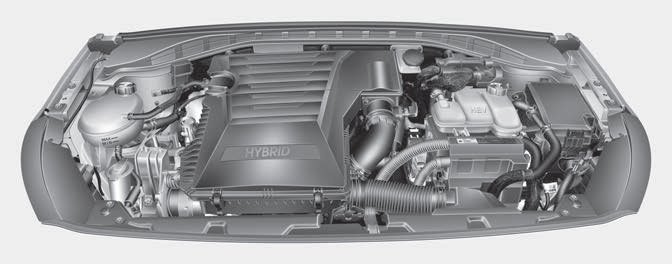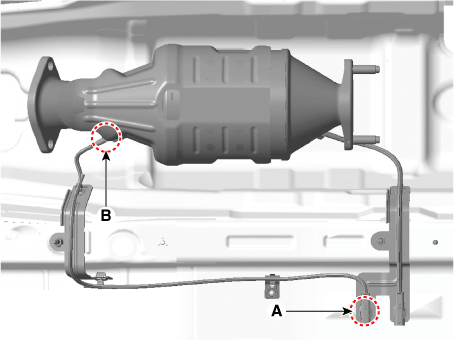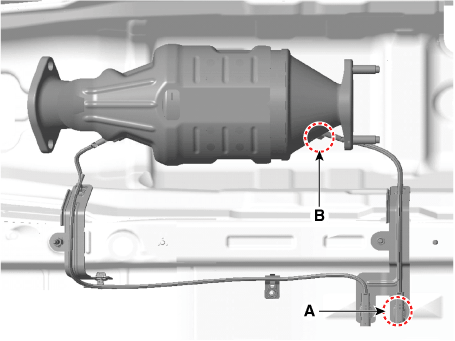Hyundai Ioniq: Engine Control System / Exhaust Gas Temperature Sensor (EGTS). Repair procedures
Hyundai Ioniq (AE) 2017-2025 Service Manual / Engine Control/Fuel System / Engine Control System / Exhaust Gas Temperature Sensor (EGTS). Repair procedures
| Inspection |
| 1. | Turn ignition switch OFF. |
| 2. | Disconnect the connector of exhaust gas temperature sensors #1/#2. |
| 3. | Measure resistance between sensor signal terminal and ground terminal. |
| 4. | Check that the resistance is within the specification. Exhaust Gas Temperature Sensor [EGTS #1, #2 (T3, T4)]
|
| Removal |
[EGTS #1 (T3)]
| 1. | Turn the ignition switch OFF and disconnect the battery negative (-) terminal. |
| 2. | Lift the vehicle. |
| 3. | Disconnect the EGTS #1 connector (A). |
| 4. | Remove the EGTS #1 (B).
|
[EGTS #2 (T4)]
| 1. | Turn the ignition switch OFF and disconnect the battery negative (-) terminal. |
| 2. | Lift the vehicle. |
| 3. | Disconnect the EGTS #2 connector (A). |
| 4. | Remove the EGTS #2 (B).
|
| Installation |
|
| 1. | Install in the reverse order of removal. |
Other information:
Hyundai Ioniq (AE) 2017-2025 Service Manual: Crash Pad Garnish. Repair procedures
Replacement[Crash pad center garnish] • When removing with a flat-tip screwdriver or remover, wrap protective tape around the tools to prevent damage to components. • Use a plastic panel removal tool to remove interior trim pieces without marring the surface...
Hyundai Ioniq (AE) 2017-2025 Service Manual: TJ Joint. Repair procedures
Disassembly • Special grease must be applied to the driveshaft joint. Do not substitute with another type of grease. • The boot band should be replaced with a new one.1.Remove the Front Driveshaft...
Categories
- Manuals Home
- 1st Generation Ioniq Owners Manual
- 1st Generation Ioniq Service Manual
- Coasting Guide (Plug-in hybrid vehicle)
- Tilt Steering / Telescope Steering
- Checking the Coolant Level
- New on site
- Most important about car
Hybrid Vehicle Engine Compartment

1. Engine oil filler cap
2. Engine oil dipstick
3. Engine coolant cap
4. Engine coolant reservoir
5. Inverter coolant reservoir
Copyright © 2025 www.hioniqae.com





